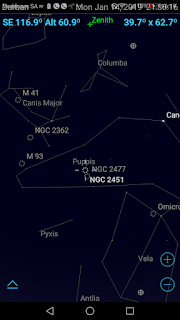Let's once again take a brief look at what to expect from our night sky this week.
Keep in mind this is from a Southern Hemisphere perspective and my home town of Durban.
So let's begin shall we.
THE MOON AND PLANETS.
The Moon will be full most of this week and we miss seeing the full eclipse from Durban as it will be best viewed by our American counterparts.
For more details on this see my previous post here: Lunar eclipse 2019
MARS continues to be a early evening planet as it gets ever further away from us and will soon be gone from our views, the next time we see it at opposition will be on the 14th October 2020.
JUPITER and VENUS still dominate the early morning skies.
URANUS is still visible in the scope from Durban in the very early evenings.
DEEP SKY OBSERVING(DSO).
With a near full Moon interfering with most DSO this week we turn our attention to some open clusters.
NGC 2451, OC in Puppis.
A lovely cluster to take in that offers as many as 40 stars in the 6-11th magnitude range.
These are centered around the bright variable star c Puppis which shines at magnitude 3.
What makes this cluster interesting is that it is actually two clusters, one in front of the other.
We have NGC 2451A and NGC 2451B, with the A cluster at 600light years and the B at 1200.
NGC 3766 OC in Centaurus, C97.
This cluster rivals the Jewel box(NGC 4755) in it's beauty in my opinion.
With a visual magnitude of +5.30 it is ideal for those full moon sessions.
Images courtesy of SkySafari 6 Pro.
ISS
The international space station makes a welcome return over our skies this week.
Be sure to get out and give the occupants a friendly wave as they pass high over our heads.
Use your binoculars and see if you can discern any shape to it as it passes over.
Here are a list of the dates and times for Durban.
Listed are the date, time visible, max height, appears and disappears.
Also be sure to check on Spot the station for sightings over your city: Spot the station
So get out there and enjoy the night skies this week!





No comments:
Post a Comment